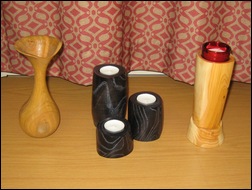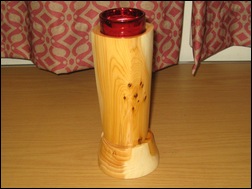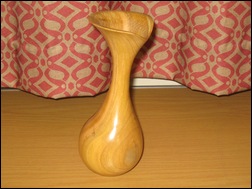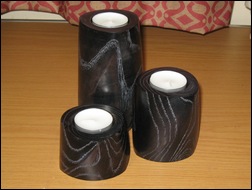Club Night Report
Wednesday 11th May 2016
Club Night Report for 11th May 2016 - observations by Vernon Hughes
 |
 |
 |
 |
 |
 |
 |
 |
This year's demonstration was to be of a flattish dish or plate with latticed rim. The practical phase opened using a pre-mounted Sycamore blank (on a screw chuck) of dimensions approx. 12" diameter by 2" thick. It had been cut from beachcombed timber found some years ago on a Dorset beach. Rod had examined it carefully when deciding which faces would be at top and bottom of the finished piece. He had also identified a flaw in the blank, a soft patch of deterioration. This was located on the underside of the plate. It was not too serious but would have been hardened by soaking in superglue if found during production in his workshop. The tailstock was brought up for additional support during shaping of the underside, which would be performed with a bowl gouge. Rod called attention to its 40 degree bevel angle which he finds far preferable to the conventional 45 degrees. The diameter of the base spigot was marked out and then formed very quickly using pulling cuts. Just as last year the thinness of his spigots is impressive at no more than say 1/8 th! Rod observed that the shape must be right in fancywork and he spent a considerable time getting the curve just to his liking, using pulling cuts throughout. He also emphasised that the diameter of the solid central section was critical and explained how to decide on it either by calculation or by an inspirational short cut. Calculation would be based on factors affecting work on the top face of the plate, i.e. the width of the router cutter, the number of slots to be cut and their spacing. The short cut emerged when he discovered that calculation always produced a figure in millimetres very close to the number of indexing points to be used, e.g. 140:144. The finished thickness of the centre would be close to 6mm. At an appropriate point he switched to a smaller gouge. Once satisfied with the shape Rod then marked out the positions of the (twelve) grooves and cut them out using a 'Mark 4' version of the fine two point tool introduced to us a year ago (it was Mark 3 then). One of our members who was obviously very familiar with the work being demonstrated asked whether the grooves could not be cut to advantage with a router and its depth stop. Rod did not rule it out but observed dryly that as turners we must do some turning (in other words use hand skill rather than mechanisation). With work on the underside now complete Rod explained that sanding would normally be undertaken at this stage. The piece was then reversed onto a spigot chuck and work commenced on the face of the plate.
 |
 |
 |
 |
 |
 |
 |
 |
 |
 |
 |
 |
This started at the edge and proceeded with frequent use of his special callipers (see last year's report) to ensure that the shape followed the profile formed at the back and that a constant thickness of 5 to 6mm was achieved. Rod switched to a smaller gouge early on to obtain greater sensitivity and he also used his left hand as a steady when required to counter some slight movement that he detected in the blank. He used a scraper to remove some unevenness observing that he likes to use negative rake scrapers due to their fineness of cut and ease in use, but they must be kept sharp! He displayed great certainty of touch as work progressed over the thin section. At the appropriate point the outline of the central solid section (140 mm) was marked out and then demarcated using a parting tool, Rod saying that the depth of cut was critical in order to obtain clean entry by the router cutter in the next stage. He would normally complete the centre shaping at this point but omitted that work to save time.
Now it was time to prepare for routing the pre-decided 144 surface slots working from centre to rim. As last year this involved mounting the indexing ring, magnetised indexing post, router bed and (variable speed) router with depth stop set. The routing task was then commenced with relevant advice being given on the feel experienced and the need for a positive pushing action to achieve a full series of smooth cuts. Rod stressed that clean cutting depends absolutely on the quality of cutter employed and that it should be thrown away after the 144 cuts. His source for the necessary quality of (printed circuit) cutters remains the same as that given in last year's report. Just a few cuts were possible in the time available but that was sufficient to demonstrate the technique. Rod rounded off by assuring us that completion of the centre section would be no problem after routing was completed, and also that little if any sanding was needed at that stage. For finishing he recommended 'Nutshell Herb & Resin Oil' - obtained from a company based in Exeter. (see website: www.nutshellpaints.co.uk). This is basically linseed oil that has been thinned. Then, quite suddenly it was all over, a sincere expression of thanks was made and the round of applause was genuinely hearty. Although this was a second visit in thirteen months to the subject of latticework Rod had held our attention throughout with his effortless and quietly commanding style, and had interesting/ useful/ fresh information to impart throughout.
The Show and Tell theme this month was: "Off-Centre Work" - which attracted a mere three entries...
 |
 |
| A finely turned off-centre vase from Mike Crawshaw in cherry |
 |
| A set of three 'twisted' tea-light holders in black stained and lime waxed ash from Harry Rock |
 |
